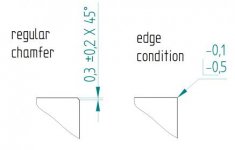Hello,
When dimensioning a chamfer on a parts drawing, according to ISO, one has to show the height of the chamfer and the angle of the chamfer (e.g 0,3x45°). And I think it`s quite similar in ANSI too. When the chamfer has to be toleranced, then one has to add the allowed deviation (e.g 0,3±0,2x45°).
But according to ISO 13 715 there is also something called Edge Condition. This allows to determine the shape of parts edges and corners.
The basic premise between those two methods is similar. So does anyone have good guess, when to prefer on method over the other, when the objective is to dimension and tolerance a chamfer?
I made a schematic, which shows both methods:

Best regards
When dimensioning a chamfer on a parts drawing, according to ISO, one has to show the height of the chamfer and the angle of the chamfer (e.g 0,3x45°). And I think it`s quite similar in ANSI too. When the chamfer has to be toleranced, then one has to add the allowed deviation (e.g 0,3±0,2x45°).
But according to ISO 13 715 there is also something called Edge Condition. This allows to determine the shape of parts edges and corners.
The basic premise between those two methods is similar. So does anyone have good guess, when to prefer on method over the other, when the objective is to dimension and tolerance a chamfer?
I made a schematic, which shows both methods:

Best regards

